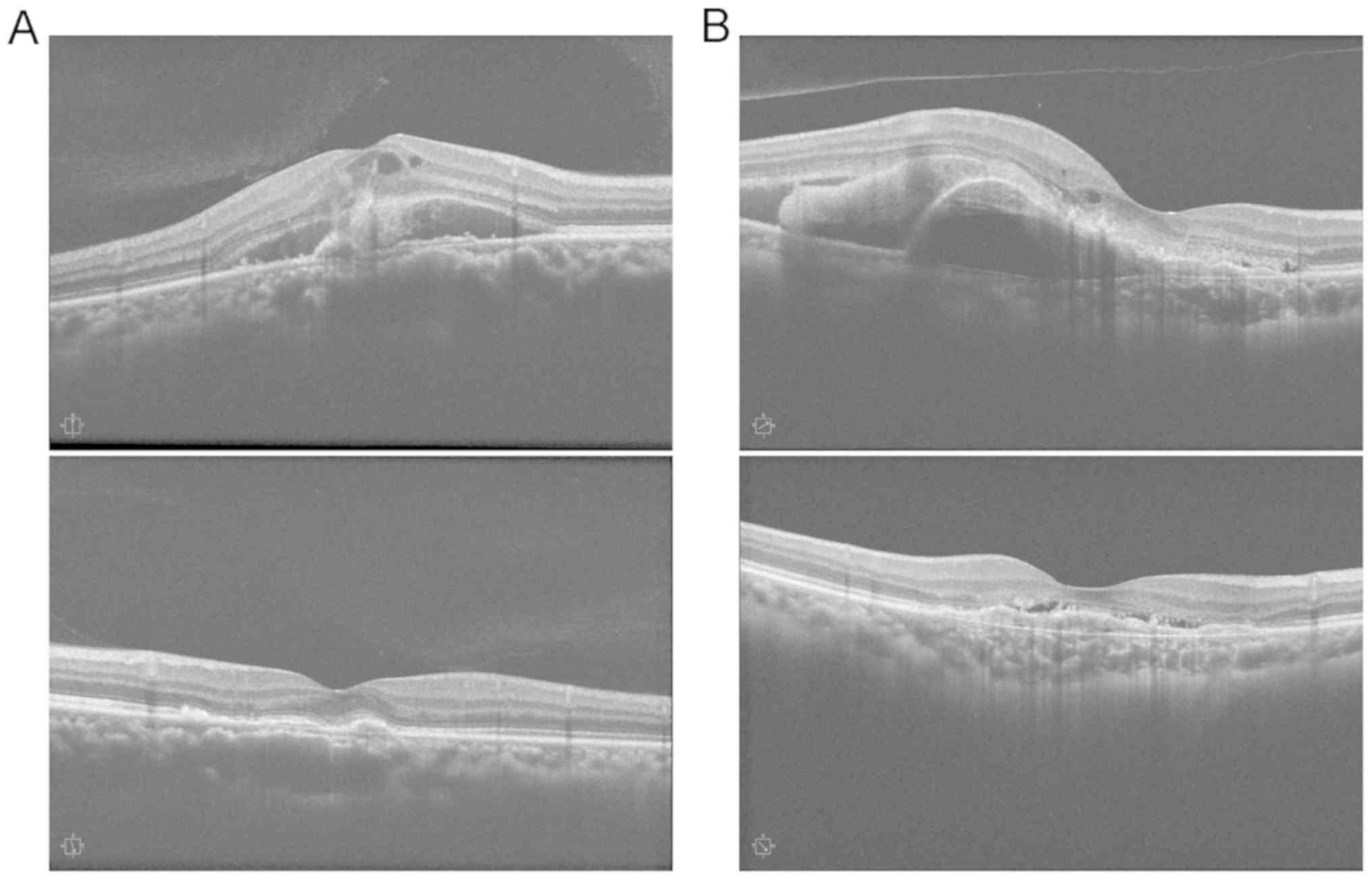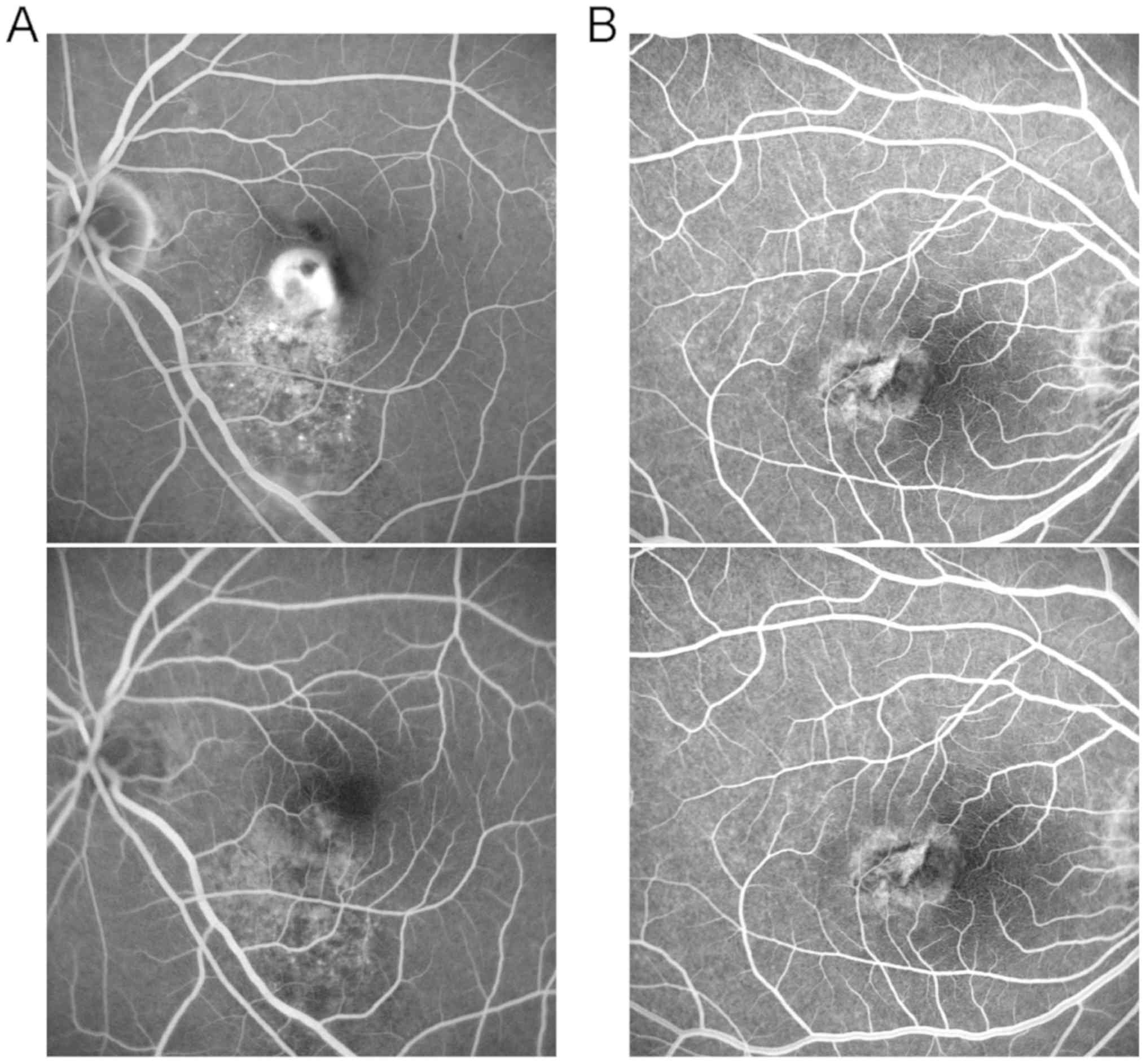|
1
|
Mehta S: Age-related macular degeneration.
Prim Care. 42:377–391. 2015.PubMed/NCBI View Article : Google Scholar
|
|
2
|
Wong CW, Yanagi Y, Lee WK, Ogura Y, Yeo I,
Wong TY and Cheung CMG: Age-related macular degeneration and
polypoidal choroidal vasculopathy in Asians. Prog Retin Eye Res.
53:107–139. 2016.PubMed/NCBI View Article : Google Scholar
|
|
3
|
Waldstein SM, Simader C, Staurenghi G,
Chong NV, Mitchell P, Jaffe GJ, Lu C, Katz TA and Schmidt-Erfurth
U: Morphology and visual acuity in aflibercept and ranibizumab
therapy for neovascular age-related macular degeneration in the
VIEW trials. Ophthalmology. 123:1521–1529. 2016.PubMed/NCBI View Article : Google Scholar
|
|
4
|
Cruess AF, Zlateva G, Pleil AM and
Wirostko B: Photodynamic therapy with verteporfin in age-related
macular degeneration: A systematic review of efficacy, safety,
treatment modifications and pharmacoeconomic properties. Acta
Ophthalmol. 87:118–132. 2009.PubMed/NCBI View Article : Google Scholar
|
|
5
|
Teper SJ, Nowinska A, Pilat J and Wylegala
E: Photodynamic therapy in VEGF inhibition non-responders -
Pharmacogenetic study in age-related macular degeneration assessed
with swept-source optical coherence tomography. Photodiagn Photodyn
Ther. 13:108–113. 2016.PubMed/NCBI View Article : Google Scholar
|
|
6
|
Saviano S, Leon PE, Mangogna A and
Tognetto D: Combined therapy (intravitreal bevacizumab plus
verteporfin photodynamic therapy) versus intravitreal bevacizumab
monotherapy for choroidal neovascularization due to age-related
macular degeneration: A 1-year follow-up study. Digit J Ophthalmol.
22:46–53. 2016.PubMed/NCBI View Article : Google Scholar
|
|
7
|
Su Y, Wu J and Gu Y: Photodynamic therapy
in combination with ranibizumab versus ranibizumab monotherapy for
wet age-related macular degeneration: A systematic review and
meta-analysis. Photodiagn Photodyn Ther. 22:263–273.
2018.PubMed/NCBI View Article : Google Scholar
|
|
8
|
Datseris I, Kontadakis GA, Diamanti R,
Datseris I, Pallikaris IG, Theodossiadis P and Tsilimbaris MK:
Prospective comparison of low-fluence photodynamic therapy combined
with intravitreal bevacizumab versus bevacizumab monotherapy for
choroidal neovascularization in age-related macular degeneration.
Semin Ophthalmol. 30:112–117. 2015.PubMed/NCBI View Article : Google Scholar
|
|
9
|
Al-Zamil WM and Yassin SA: Recent
developments in age-related macular degeneration: A review. Clin
Interv Aging. 12:1313–1330. 2017.PubMed/NCBI View Article : Google Scholar
|
|
10
|
Mitchell P, Liew G, Gopinath B and Wong
TY: Age-related macular degeneration. Lancet. 392:1147–1159.
2018.PubMed/NCBI View Article : Google Scholar
|
|
11
|
Rufai SR, Almuhtaseb H, Paul RM, Stuart
BL, Kendrick T, Lee H and Lotery AJ: A systematic review to assess
the 'treat-and-extend’ dosing regimen for neovascular age-related
macular degeneration using ranibizumab. Eye (Lond). 31:1337–1344.
2017.PubMed/NCBI View Article : Google Scholar
|
|
12
|
Singh CN and Saperstein DA: Combination
treatment with reduced-fluence photodynamic therapy and
intravitreal injection of triamcinolone for subfoveal choroidal
neovascularization in macular degeneration. Retina. 28:789–793.
2008.PubMed/NCBI View Article : Google Scholar
|
|
13
|
Kang EC, Seo JG, Kim BR and Koh HJ:
Clinical outcomes of Iintravitreal bevacizumab versus photodynamic
therapy with or without bevacizumab for myopic choroidal
neovascularization: A 7-year follow-up study. Retina. 37:1775–1783.
2017.PubMed/NCBI View Article : Google Scholar
|
|
14
|
Spielberg L and Leys A: Treatment of
neovascular age-related macular degeneration with a variable
ranibizumab dosing regimen and one-time reduced-fluence
photodynamic therapy: The TORPEDO trial at 2 years. Graefes Arch
Clin Exp Ophthalmol. 248:943–956. 2010.PubMed/NCBI View Article : Google Scholar
|
|
15
|
Nakamura T, Miyakoshi A, Fujita K, Yunoki
T, Mitarai K, Yanagisawa S, Fuchizawa C and Hayashi A: One-year
results of photodynamic therapy combined with intravitreal
ranibizumab for exudative age-related macular degeneration. J
Ophthalmol. 2012(154659)2012.PubMed/NCBI View Article : Google Scholar
|
|
16
|
Saviano S, Piermarocchi R, Leon PE,
Mangogna A, Zanei A, Cavarzeran Sc F and Tognetto D: Combined
therapy with bevacizumab and photodynamic therapy for myopic
choroidal neovascularization: A one-year follow-up controlled
study. Int J Ophthalmol. 7:335–339. 2014.PubMed/NCBI View Article : Google Scholar
|
|
17
|
Potter MJ, Claudio CC and Szabo SM: A
randomised trial of bevacizumab and reduced light dose photodynamic
therapy in age-related macular degeneration: The VIA study. Br J
Ophthalmol. 94:174–179. 2010.PubMed/NCBI View Article : Google Scholar
|
|
18
|
Kim HW, Kim JL, Lee MH, Yoo HG, Chung IY
and Lee JE: Combined treatment of photodynamic therapy and
bevacizumab for choroidal neovascularization secondary to
age-related macular degeneration. Korean J Ophthalmol. 25:231–237.
2011.PubMed/NCBI View Article : Google Scholar
|
|
19
|
Cheung GCM, Lai TYY, Gomi F, Ruamviboonsuk
P, Koh A and Lee WK: Anti-VEGF therapy for neovascular AMD and
polypoidal choroidal vasculopathy. Asia Pac J Ophthalmol (Phila).
6:527–534. 2017.PubMed/NCBI View Article : Google Scholar
|
|
20
|
Tosi GM, Caldi E, Neri G, Nuti E,
Marigliani D, Baiocchi S, Traversi C, Cevenini G, Tarantello A,
Fusco F, et al: HTRA1 and TGF-β1 concentrations in the aqueous
humor of patients with neovascular age-related macular
degeneration. Invest Ophthalmol Vis Sci. 58:162–167.
2017.PubMed/NCBI View Article : Google Scholar
|
|
21
|
Cabral T, Mello LGM, Lima LH, Polido J,
Regatieri CV, Belfort R Jr and Mahajan VB: Retinal and choroidal
angiogenesis: A review of new targets. Int J Retina Vitreous.
3(31)2017.PubMed/NCBI View Article : Google Scholar
|

















